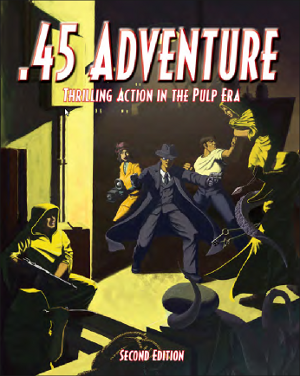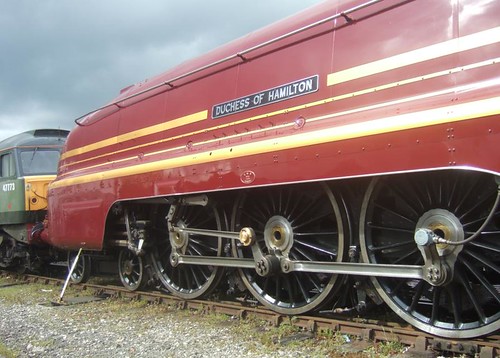Rattrap Productions released the much-anticipated 2nd Edition of their .45 Adventures pulp adventure rules a few weeks ago, I received my copy of the full rules last week, and I’ve already run one convention game and several small private test games with the demo rules before even getting the full rules.
The PDF version should be out shortly too, as Rattrap generally releases the PDF version about a month after the initial print release. (Edit to add: the PDF version is out today.)
This review is mostly aimed at folks who have some familiarity with the 1st Edition of 45A, but it should be general enough to give those of you with no experience at all with the system an idea of how it works. Note that throughout this review I’ve used “45A1e” and “45A2e” for 1st & 2nd Edition respectively; this is a bit of a D&D-ism but useful shorthand!
So What’s Changed?
The most obvious change from 45A1e to 45A2e is the “fistfuls of d10” change. Instead of the previous version’s “1d10 + Stat +/- modifiers”, 2e is almost always “1d10 + stat +/- extra d10s depending on skills or circumstance”. You pick the best of the rolls if you’re rolling multiple d10. In practice, this seems to work out at around 3d10 per attack roll and 1d10 or 2d10 for the defender most of the time, so while you might need a few extra d10 for larger games, just to keep things moving, it’s not a really serious “fistfuls of dice” game the way Full Thrust or some of the GW games are!
Almost all the rules from 45A1e now in the one new 45A2e book. Basic gangsters, cops, crime-fighters, military, super science & robots, safari characters, all in one cover, along with all the skills. This alone makes character creation much easier, as the archetypes, skills and special rules aren’t spread over half a dozen books anymore! The campaign rules and New Commerce City background material have been rolled into the main rulebook as well.
Character creation is also massively streamlined. Rather than lists of specific skills available to specific archetypes, the archetypes have different numbers of skills they can take per skill category, and all the skills are now slotted into one of these 11 categories. This will also make integrating future supplements and releases easier!
Weapons are no longer purchased as part of a character’s basic build. Instead, they’re purchased per-scenario using Equipment Points. This means, among other things, that Grade 1 & 2 characters can often take more Special Abilities than before, as they’re not having a significant part of their available Special Ability count taken up with weaponry. (Giving a Grade 1 flunky a tommy gun used to soak up 3 of their 4 available Ability slots in 45A1e, now a Grade 1 can actually have four skills and the gun!)
What’s Brand New?
The whole Occult section is new, with rules for various Cthulhu-esque creatures, cultists and goings on, spells, artifacts and such. I haven’t had a chance to use these in play yet, but they look entertaining.
The entire Special Abilities/Skills list has been rewritten and consolidated. There’s a bunch of new or replacement skills, some duplicated stuff removed, and a rather elegant hierarchy of skills has been implemented for a few areas.
A couple of my favourite archetypes from 45A1e didn’t make it into 45A2e, namely the Foreign Agent & Professor archetypes. On the other tentacle, the G-Man archetype should encompass the old Foreign Agent one quite well, and there is now an archetype creation formula so you can roll your own if you really want to.
The archetype creation rules were much requested for 45A1e, so it’s great to see them included with 2e. I haven’t really played with them yet, but a read-through and examination of how the included archetypes are assembled lead me to think the creation rules should work just fine. (the stock archetypes included in the rules appear to have been built using the actual archetype creation rules as presented, which is always a good sign!)
Weaponry, as mentioned above, is no longer bought as part of a character’s build process, but instead it’s done using Equipment Points which can change on a per-scenario basis. This gives players and GMs greater flexibility – you can restrict weapons in a scenario without players feeling like they’ve “wasted” a lot of a character’s build options, control the amount of firepower on the table, etc. The Equipment List also encompasses a lot of non-weaponry equipment, too, things that might be useful in certain scenarios like flashlights, ropes or even multi-language translating dictionaries.
The Super Science & Occult equipment is controlled the same way, with seperate Super Science & Occult Equipment Points. Certain archetypes give bonuses to various of these Equipment Points totals – the Military Officer gets +10 Equipment Points, the Witch Doctor +10 Occult Points, for example.
A Few Issues
Typos and grammar errors! There’s a typo in the Table of Contents (“Resaerch” instead of “Research”) that should have been caught by a simple spellchecker (not the only time I noticed this in the book) and a few grammar glitches (its/it’s, that sort of thing) recurring. None of them that I’ve noticed so far occur where they’d cause rules ambiguity or misinterpretation, at least.
(Corey’s interjection: Amongst the many jobs I do, I am a part-time writer and copy-editor, so the mistakes in the book, especially with regards to the lack of a style guide, really bug me, to the point where I had to put down the book and walk away at one point. Sorry Rich. )(Brian’s re-interjection: Unless you’re a hardass about editing, the concerns I noted in the previous paragraph really aren’t showstoppers…)
There are a number of layout glitches that make some things hard to read than they should be, especially when searching quickly for a specific rule or skill. One example is the lack of differentiation between sub-section headings (just made using bold text) and some lists, some of which use bold to make their titles stand out and some of which don’t. The Special Abilities Lists are easy to read, but the similar Robot Upgrades List re-uses bold text for two different things (sub-section headers and upgrade titles). A second style for those sub-section headers would make some sections of the book much easier to scan, especially in mid-game when you’ve had to pause the action to clarify a rule.
Beyond layout and grammar, as I said above, some of the old 45A1e archetypes haven’t made the cut. There’s also a few toys and weapons missing, but for ordinary games that’s not going to be a huge concern, as the most notable missing weapons are the Light & Medium Machine Guns from the Amazing War Stories military supplement, hardly common weapons in typical 45A games!
The Verdict
These are all very minor issues, though. The new character stat/wound boxes are far more compact than the old ones, so it should be possible to get more characters onto less paper now – and less paper in front of players during a game is rarely a bad thing!
The new “fistfuls of d10” combat/skills system runs faster on the table. Characters move faster, Grade Ones (the mooks, thugs, extras, Privates and redshirts of the factions) die quicker while Grade Threes (the Stars!) are a bit tougher but not hugely so. It’s entirely in keeping with the heroic/cinematic traditions of pulp that major characters should be able to plow through crowds of extras, anyway!
So, the final verdict? .45 Adventures 2nd Edition is just as detailed, playable and flavourful as the old, but the new system is faster, leaner and pulpier.
Streamlined, in fact. Very pulp-era thing to do, actually!


